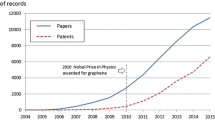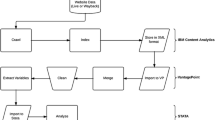Abstract
We explore pilot web-based methods to probe the strategies followed by new small and medium-sized technology-based firms as they seek to commercialize emerging technologies. Tracking and understanding the behavior of such early commercial entrants is not straightforward because smaller firms with limited resources do not always widely engage in readily visible and accessible activities such as publishing and patenting. However, many new firms, even if small, present information about themselves that is available online. Focusing on the early commercialization of novel graphene technologies, we introduce a “web scraping” approach to systematically capture information contained in the online web pages of a sample of small and medium-sized high technology graphene firms in the US, UK, and China. We analyze this information and devise measures that gauge how firm specialization in the target technology impacts overall market orientation. Three groups of graphene enterprises are identified which vary by their focus on product development, materials development, and integration into existing product portfolios. Country-level factors are important in understanding these early diverging commercial approaches in the nascent graphene market. We consider management and policy implications of our findings, and discuss the value, including strengths and weaknesses, of web scraping as an additional information source on enterprise strategies in emerging technologies.


Similar content being viewed by others
References
Abernathy, W., & Utterback, J. (1978). Patterns of industrial innovation. Technology Review, 80(7), 40–47.
Ahuja, G., Lampert, C. M., & Tandon, V. (2008). Moving beyond Schumpeter: Management research on the determinants of technological innovation. Academy of Management Annals, 2, 1–98.
Arora, A., & Gambardella, A. (1994). The changing technology of technological change: General and abstract knowledge and the division of innovative labour. Research Policy, 23, 523–532.
Auerswald, P. E. (2007). The simple economics of technology entrepreneurship: Market failure reconsidered. In D. B. Audretsch, I. Grilo, & A. R. Thurik (Eds.), Handbook of research on entrepreneurship policy (pp. 18–35). Cheltenham, UK: Edward Elgar.
Autio, E. (1997a). “Atomistic” and “Systemic” approaches to research on new, technology-based firms: A literature study. Small Business Economics, 9(3), 195–209.
Autio, E. (1997b). New, technology-based firms in innovation networks symplectic and generative impacts. Research Policy, 26(3), 263–281.
Autio, E. (2004). Creative tension: the significance of Ben Oviatt’s and Patricia McDougall’s article “toward a theory of international new ventures”. Journal of International Business Studies, 36(1), 9–19.
Barney, J. B. (1991). Firm resources and sustained competitive advantage. Journal of Management, 17, 99–120.
Brouwer, E. & Kleinknecht, A. (1999). Innovative output, and a firm’s propensity to patent: An exploration of CIS micro data. Research Policy, 28(6), 615–624.
Cohen, W. M., & Levinthal, D. A. (1990). Absorptive capacity: A new perspective on learning and innovation. Administrative Sciences Quarterly, 35(1), 569–596.
Cosh, A., & Hughes, A. (2009). Never mind the quality feel the width: University–industry links and government financial support for innovation in small high technology businesses in the UK and the USA. The Journal of Technology Transfer, 35(1), 66–91.
Department for Business, Innovation and Skills. (2011, Oct. 3). £50 million hub to commercialise Nobel Prize winning material. Central Office of Information, News Distribution Service. http://nds.coi.gov.uk/content/Detail.aspx?ReleaseID=421451&NewsAreaID=2. Accessed January 20, 2012.
Eisenhardt, K. M., & Martin, J. A. (2000). Dynamic capabilities: What are they? Strategic Management Journal, 21(10–11), 1105–1121.
Gabrielsson, M., & Gabrielsson, P. (2011). Internet-based sales channel strategies of born global firms. International Business Review, 20(1), 88–99. doi:10.1016/j.ibusrev.2010.05.001.
Gabrielsson, M., Kirpalani, V. H. M., Dimitratos, P., Solberg, C. A., & Zucchella, A. (2008). Born globals: Propositions to help advance the theory. International Business Review, 17(4), 385–401. doi:10.1016/j.ibusrev.2008.02.015.
Geim, A. K., & Novoselov, K. S. (2007). The rise of graphene. Nature Materials, 6(3), 183–191.
Gilbert, R., & Newbery, D. (1982). Preemptive pantenting and the persistence of monopoly. The American Economic Review, 72(3), 514–526.
Hagen, B., Zucchella, A., Cerchiello, P., & De Giovanni, N. (2011). International strategy and performance—Clustering strategic types of SMEs. International Business Review,. doi:10.1016/j.ibusrev.2011.04.002.
Katz, J. S. (2006). Web indicators for complex innovation systems. Research Evaluation, 15(2), 85–95.
Kim, J. H. (2012). A hyperlink and semantic network analysis of the triple helix (University-Government-Industry): The interorganizational communication structure of nanotechnology. Journal of Computer-Mediated Communication, 17(2), 152–170. doi:10.1111/j.1083-6101.2011.01564.x.
Rasmussen E. & Madsen, T. (2002). The born global concept. Presented at the European International Business Academy, 2002. http://www.sam.sdu.dk/~era/EIBA%20Rasmussen%202002%20.pdf. Accessed February 10, 2011.
Malecki, E. J. (1997). Technology & economic development (2nd ed.). Essex, UK: Addison Wesley Longman.
Davis P., Maslov, A., & Phillips, S. (2005). Analyzing history in hypermedia collections. In Proceedings of the sixteenth ACM conference on hypertext and hypermedia (pp. 171–173).
Michael, S. C., & Pearce, J. A. (2009). The need for innovation as a rationale for government involvement in entrepreneurship. Entrepreneurship & Regional Development, 21(3), 285–302.
Miyazaki, K., & Islam, N. (2007). Nanotechnology systems of innovation—An analysis of industry and academia research activities. Technovation, 27(11), 661–675.
Mowery, D., & Sampat, B. (2006). Universities in national innovation systems. In J. Fagerberg, D. Mowery, & R. Nelson (Eds.), The Oxford handbook of innovation (pp. 209–239). Oxford, UK: Oxford University Press.
Novoselov, K. S., Fal’ko, V. I., Colombo, L., Gellert, P. R., Schwab, M. G., & Kim, K. (2012). A roadmap for graphene. Nature, 490, 192–200.
OECD. (2010). The Impacts of Nanotechnology on Companies: Policy Insights from Case Studies. Paris: OECD Publishing.
Oviatt, B. M., & McDougall, P. P. (2004). Toward a theory of international new ventures. Journal of International Business Studies, 36(1), 29–41.
Porter, A. L., Guo, Y., Huang, L., & Robinson, D. K. R. (2010). Forecasting Innovation Pathways: The Case of Nano-enhanced Solar Cells. In International conference on technological innovation and competitive technical intelligence (ITICTI), Beijing.
Rennie, M. W. (1993). Born global. McKinsey Quarterly, 1993(4), 45–52.
Research, Lux. (2007). The nanotech report: Investment overview and market research for nanotechnology (5th ed.). New York: Lux Research.
Sandhu, A. (2007). The birth of nanoChina. Nature Nanotechnology, 2(1), 11–12.
Segal, M. (2009). Selling graphene by the ton. Nature Nanotechnology, 4(10), 612–614.
Shapira, P., & Wang, J. (2009). From lab to market: Strategies and issues in the commercialization of nanotechnology in China. Asian Business & Management, 8, 461–489.
Shapira, P., & Wang, J. (2010). Follow the money. Nature, 468, 627–628.
Shapira, P., Youtie, J., & Arora, S. (2012). Early patterns of commercialization of graphene. Journal of Nanoparticle Research,. doi:10.1007/s11051-012-0811-y.
Shapira, P., Youtie, J., & Kay, L. (2011). National innovation systems and the globalization of nanotechnology innovation. The Journal of Technology Transfer, 36(6), 587–604.
Tripsas, M. (1997). Unraveling the process of creative destruction: Complementary assets and incumbent survival in the typesetter industry. Strategic Management Journal, 18(S1), 119–142.
Van Noorden, R. (2011). Chemistry: The trials of new carbon. Nature, 469, 14–16.
Walker, W. (1993). National innovation systems: Britain. In R. Nelson (Ed.), National innovation systems: A comparative analysis (pp. 158–191). New York: Oxford University Press.
Wessner, C. (2007). Government programs to encourage innovation by start-ups and SMEs: The role of US innovation awards. In D. B. Audretsch, I. Grilo, & A. R. Thurik (Eds.), Handbook of research on entrepreneurship policy (pp. 172–185). Cheltenham, UK: Edward Elgar.
Youtie, J., Hicks, D., Shapira, P., & Horsley, T. (2012). Pathways from discovery to commercialization: Using web sources to track small and medium-sized enterprises strategies in emerging nanotechnologies. Technology Analysis and Strategic Management, 24(10), 981–995.
Youtie, J., Shapira, P., & Porter, A. L. (2008). Nanotechnology publications and citations by leading countries and blocs. Journal of Nanoparticle Research, 10(6), 981–986.
Yu, J., Stough, R. R., & Nijkamp, P. (2009). Governing technological entrepreneurship in China and the West. Public Administration Review, 69(S1), S95–S100.
Zhou, P., & Leydesdorff, L. (2006). The emergence of China as a leading nation in science. Research Policy, 35(1), 83–104.
Acknowledgments
Support for this research was provided through the Center for Nanotechnology in Society at Arizona State University (National Science Foundation Award 0531194). Additional support was provided by the Manchester Institute of Innovation Research, the Georgia Tech Program in Science, Technology and Innovation Policy, and the Manchester-Atlanta-Beijing Innovation Co-Lab (with support from the British Council UK-US New Partnership Fund—Prime Minister’s Initiative for International Education). The findings in this paper are those of the authors and do not necessarily reflect the views of the National Science Foundation, the authors’ institutions, or the other sponsors.
Author information
Authors and Affiliations
Corresponding author
Rights and permissions
About this article
Cite this article
Arora, S.K., Youtie, J., Shapira, P. et al. Entry strategies in an emerging technology: a pilot web-based study of graphene firms. Scientometrics 95, 1189–1207 (2013). https://doi.org/10.1007/s11192-013-0950-7
Received:
Published:
Issue Date:
DOI: https://doi.org/10.1007/s11192-013-0950-7
Keywords
- Emerging technology
- Graphene
- Small and medium enterprise
- Commercialization
- Market entry
- Web scraping
- United States
- United Kingdom
- China




